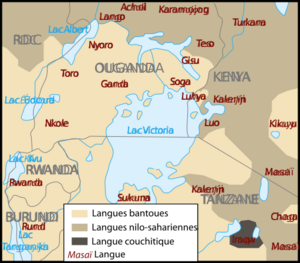Lake Victoria facts for kids
Lake Victoria, also called Victoria Nyanza, is a huge lake in Africa. It is also known by local names like Ukerewe and Nnalubaale. This amazing lake is shared by three countries: Tanzania, Uganda, and Kenya. It sits in the western part of Africa's Great Rift Valley, a giant crack in the Earth's surface.
Lake Victoria covers about 68,800 square kilometres (26,560 mi²). This makes it the largest lake in Africa. It is also the second largest fresh water lake in the entire world! The lake was named after Queen Victoria of the United Kingdom. A very important river, the White Nile, starts its long journey from Lake Victoria.
Contents
Discovering Lake Victoria
Who Found Lake Victoria?
A British explorer named John Hanning Speke was the first European to see Lake Victoria. He reached the lake in 1858. Speke was on a trip to find the source of the Nile River. He named the lake after Queen Victoria.
How Was the Lake Formed?
Lake Victoria is quite shallow for its size. It was formed about 400,000 years ago. This happened when rivers flowing west were blocked by land rising up. This created a huge basin that filled with water. The lake has dried up completely at least three times in the past. The last time it dried up was about 15,000 years ago. This was during a very dry period in Africa.
Geography and Climate
Where is Lake Victoria Located?
Lake Victoria is located on a high plateau in the western part of East Africa. It is surrounded by hills and plains. The lake's water comes mostly from rain falling directly on its surface. Many smaller rivers also flow into it. The largest river flowing into Lake Victoria is the Kagera River.
What is the Weather Like?
The area around Lake Victoria has a tropical climate. This means it is generally warm all year round. There are two main rainy seasons. One is from March to May, and the other is from October to November. The lake's large size helps to control the local weather. It makes the air around it more humid and brings more rainfall.
Wildlife and Environment
Animals in Lake Victoria
Lake Victoria is home to many different kinds of animals. It is especially famous for its many types of cichlid fish. These fish are known for their bright colors and unique behaviors. Many other fish, birds, and reptiles also live in and around the lake. Some common animals include hippos, crocodiles, and various water birds.
Challenges for the Lake
Sadly, Lake Victoria faces some big environmental problems. One major issue is the introduction of the Nile perch. This large fish was brought to the lake in the 1950s. It was meant to boost fishing. However, the Nile perch ate many of the native cichlid fish. This led to a huge loss of different fish species.
Another problem is water hyacinth. This is a fast-growing plant that covers parts of the lake. It blocks sunlight and makes it hard for fish to breathe. Pollution from farms and towns also harms the lake. These issues affect the lake's health and the people who depend on it.
People and Economy
Life Around the Lake
Millions of people live around Lake Victoria. Many of them rely on the lake for their daily lives. Fishing is a very important activity. People catch fish for food and to sell. The lake also provides water for drinking and farming.
Transportation and Trade
Lake Victoria is used for transport. Boats and ferries carry people and goods between different towns and countries around the lake. This helps with trade and connects communities. Tourism is also growing, with visitors coming to see the lake's beauty and wildlife.
Images for kids
-
Lake Victoria bathymetric model
-
Unlike many other Lake Victoria cichlids, Haplochromis nyererei remains common. Compared to several other cichlids, its eyes are particularly sensitive to light, especially red, which is less affected by the decrease in water clarity caused by eutrophication than short wavelength colors
-
The Nile perch was introduced to Lake Victoria for fishing, and can reach up to 2 m (6.6 ft) and 200 kg (440 lb).
See also
 In Spanish: Lago Victoria para niños
In Spanish: Lago Victoria para niños
















